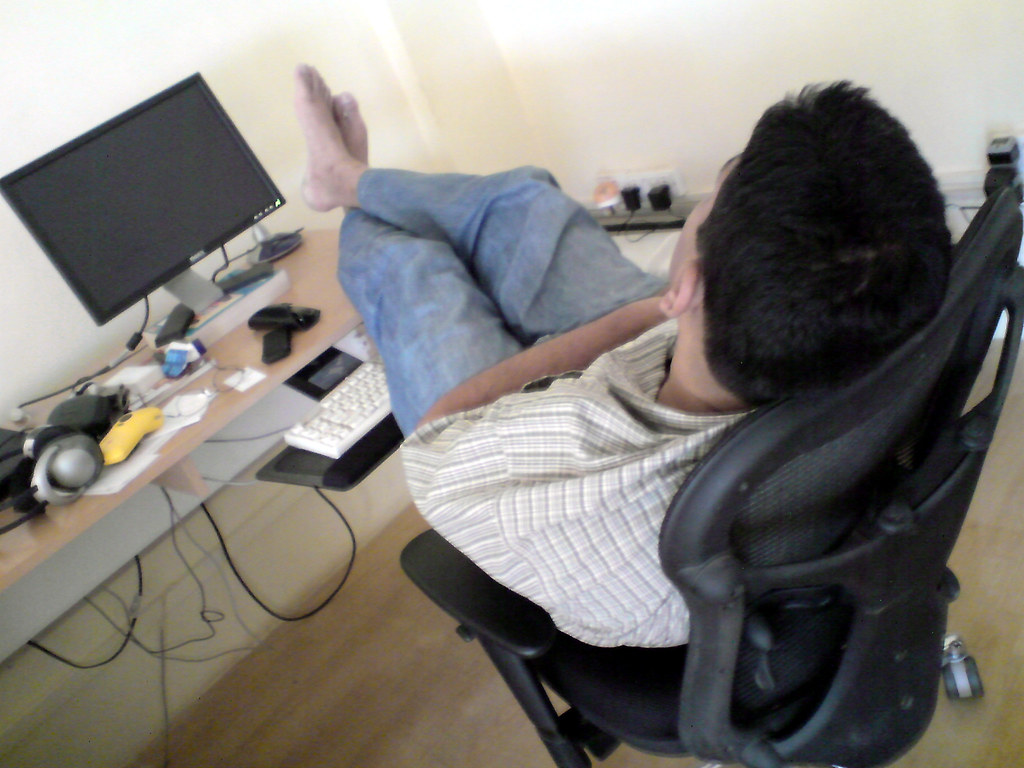
It was day two of my first graphic design class ever. My first semester studying this topic. I had spent hours gluing natural objects I found to my poster board to create a composition worthy of my professor’s love. I scrounged for flowers, sticks, leaves, grass, whatever fit on the page and filled up all the white space with carefully arranged objects. I held it up, squinted, and looked at it from afar. I thought I did a pretty good job. I carried in my poster with confidence.
“Put the posters on the chalkboard with this tape, Prof F said, as he pointed to the ancient tape dispenser. “And then sit down quietly at your desk.”
We all did what we were told. My confidence began shrinking as I watched him peer at the posters, pacing back and forth, contemplating. He finally stopped pacing right in front of the first poster.
“This one sucks,” he said and tore it off the board to let it float softly to its death.
Then he walked up to the second poster, mine. My heart raced, my face felt flushed and I held my breath.
“Terrible, cluttered. a mess.” He pulled it off the board and let it fall.
I saw one of my classmates, one of those girls with her hair perfectly straight, bangs even, pressed clothes in the latest trends. She smirked. Confident. Shoulders back.
Prof F walked to her poster next. “This one is perfect.” He paused. Smiles. “She doesn’t stick things all haphazard all over the poster, it is in perfect balance, this giant sunflower contrasts with the seeds in the background. She doesn’t select too many objects. No chaos. Everything is carefully assembled with effort.”
Prof F continued to walk down the board, ripping 90% of the posters off the wall, and berating everyone’s work until only 2 posters remained hanging. We sat agape. Our mouths were wide open. Hurt seeped through our pores. Prof F was weeding us out. Who had the guts to stay in a career with so much criticism? Who had the grit to keep improving? Who had the mental strength to handle the rejection that would come again and again?
If you tried defending your work, it was a death sentence. He taught us the client was always right and we didn’t yet have the vocabulary or the skills to give a convincing explanation of why our design should have been well received. This was industry training and looking back I am grateful I had this experience because pleasing clients can be like this.
What I also began to learn was how to spot bad graphic design, which honestly was about 80% of anything that existed in the world. Learning to self-edit was one of the hardest skills to master. And, even as a business owner, I will often run concepts and designs by my business partner before sending them off to the client. The client should only see your best work. It should be close to flawless when they get it, and the design should exhibit all the graphic design principles in this book. Graphic Design for Course Creators will help you to become discerning, and work toward improving your own work.
Spotting the very few designs that were worthy of our attention became the central focus of that first design course. Building that skill helped us to become confident in recognizing the differences between good and bad design in our own work and everything that existed beyond it.
We worked in a variety of media after that first assignment. But no matter what medium we chose, we also learned never to blame our tools. Technologies come and go, but good design is here to stay. You must be able to apply it in any medium with any tool. Whether you are creating a job aid as a poster in an office setting, or a course in Rise or Storyline, or an interactive infographic in Genially, or a semester-long class in Canvas or Blackboard – a poor artist blames his tools.
Good design can be created with anything. And polishing bad design with a fancy new tool is just as ineffective as a poster full of randomly found leaves and sticks. Applying the principles in this book will elevate your portfolio, wow your clients, and help land your dream job. The power of visual aesthetics can transform courses and help make learning both more enjoyable and inclusive.
Ad Agencies, Publishing Firms, and Entrepreneurship
In undergrad, I was able to secure some highly competitive internships in Manhattan, where I worked on some exciting Fortune 500 accounts. I loved my walk from Penn Station, where I would soak up every inch of billboard, poster, flyer, and storefront. Design is so entrenched in NYC and the pace and excitement are unmatched. One of my favorite accounts was actually an off-Broadway theater called the Vineyard Theater, where the original Avenue Q production started. I was lucky to have read the script before it set the stage and helped to design some of the posters and ads. My first major was a double major in theater and communications before I transferred schools and majored in visual communications.
After undergrad, I got my first full-time position at a local publishing company where I was responsible for laying out four weekly newspapers and designing all the ads as well. It was a fast-paced environment with long hours. The best part of that job was my boss, who later became my father-in-law. He saw talent and a strong work ethic and up until his untimely death in 2021, we enjoyed talking shop. I didn’t always agree with the political views but I loved the intellectual atmosphere of the newspaper industry and when my husband and I moved to Colorado, I continued to work in newspapers and magazines first at an organization called Mile High Newspapers where the first user-generated website in Colorado was born and then later at Colorado Hometown Newspapers.

In 2006, I made the decision to go back to school for my Master of Fine Arts in Advertising. I was one of the first online students at the Academy of Art University, so my first experience in online education was as a student. I remember the platform at the time was very simple, and easy to use but there weren’t any live webinars at the time. We had a place for a digital portfolio, a discussion board, and a place to upload assignments but the Learning Management System was quite pared down compared to what we see in an LMS today.
What was great about the program was that it was immersive and experiential. We did tons of project-based work, group work/collaboration and produced projects for our portfolio as our assignments. One of my favorite parts of the program was that the instructors were actual professionals working in the field. We were paired up with people who had jobs we were looking for. After the birth of my first two kids, we decided to move back to New York and so I had the experience of working with some of the top minds (who were also my instructors) in some amazing NYC ad agencies. I got to work at some incredible ad agencies, creatives and some amazing accounts including Brand Buzz, Ammirati, and Amalgamated. This immersive experience allowed me to gain some incredible Fortune 500 account experience and network with some of the most brilliant minds in advertising. I very much enjoyed working in Manhattan but quickly realized the commute and schedules were tough on a new mom and because the MFA is considered a terminal degree, I decided to pursue teaching upon graduation.

The day after I presented/defended my thesis and graduated from the program, I walked straight into the graphic design department head’s office at the local community college and handed my resume in. I was first hired as a marketing assistant in the Applied Arts department and one year later, I was teaching my first courses. I taught face-to-face while using the D2L platform as a place to store content, program assessments, and grade and later used the Blackboard platform when the school made the switch.
Since they weren’t hiring a full-time instructor, I started teaching at two other universities as an adjunct professor, one fully online and one face-to-face. For the next few years, I taught a number of courses including branding, advertising, new media, technology in education, communications, public speaking, Adobe Creative Suite software, basic graphic design, introduction to computers, time-based media, and digital design freshman seminar. I often created my own curricular materials, assessments, and interactive experiences, and when possible, I also chose the resources or textbook. It was only in the online university that I had little control of the curriculum, textbook, or assessments and this experience first piqued my passion for instructional design. I knew I couldn’t modify the learning management system and I often felt constrained. This haunted me for years and I did my best to read up, even back then, on teaching and learning strategies in the online education space. My thirst for understanding the literature and how I could apply it would prompt me to start my Doctoral journey a few years later.
Since I have always believed that instructors should also have industry experience, I continued to freelance as well. Around this time, I met my business partner Joanna and after realizing our skill sets complimented each other and we saw a need for producing high-end Madison Avenue quality design to the east end of Long Island, we decided to open up shop together. I had education, advertising, and publishing experience and she had pharma, publishing, and packaging experience. I had more experience in writing and account management and she had more in art direction and production. She was a detail person; I was a big picture person. She was laid back and chill, I was high energy. It was a perfect match. In February of 2012, East End Advertising was born.

This launched an exciting time working with some amazing clients and delivering high-quality designs to mission-driven organizations. I gravitated towards non-profit and education/workforce clients and she did a lot of the fun apparel and high-end consumer goods, but in the end, we always collaborated, bounced ideas off each other, and worked together to produce work we could be proud of. Over the years, we hired many different vendors, and subcontractors, and even some former students of mine. I enjoyed mentoring them and helping them build their portfolios and careers.
When I started my doctoral journey, I was looking for a way to marry my love of Education and Design and the program I selected was a practitioner management degree that was one part change management and one part instructional design. Once again, I chose an online program. I was impressed with the level of support I received, especially during the dissertation phase.
Since I was passionate about improving the experiences of online students and I was at the time teaching public speaking online, I chose a topic that explored how the curriculum could improve the oral communication skills of online learners. At the time, most of the assessments, communication, and correspondence of online students were in written form. I wanted to know what higher education instructors who taught public speaking across the US were doing to improve the oral communication skills of their students.
I completed my program in March of 2020, right at the time the entire world was shutting down from Covid-19. My skill set and expertise in online pedagogy became in high demand and I quickly took on an instructional design client, Brighter Higher Ed, where we helped design online professional development courses and offerings for higher education faculty and administrators. Not only did we design courses, but we also wrote articles, helped rebrand the organization, and designed graphics. One of my favorite things was getting to be one of the first readers of the book Radical Empathy and brainstorming how to translate this into a professional development offering.
In September of 2020, I started a contract with Harvard Graduate School of Education as a learning designer working in the Ethnic Racial Identity Lab. This experience helped progress my DEI journey as I was able to help design and build an online version of a curriculum that equipped educators to have conversations about race and ethnicity in their classrooms. The work was fulfilling, intellectually and creatively challenging, and most important, mission-driven. After I completed my work with the AERID lab, I then finished my contract with the Teaching and Learning Lab, where I got to take a deep dive into digital accessibility and inclusive online pedagogy. I worked hard to improve curricular materials with an eye for revising language, improving accessibility, and including things like diverse image representation.
At the same time, I was working with Harvard, I also had the opportunity to work on a course with ONEHE and Dr. Thomas J. Tobins is a faculty developer, professional consultant, author, and international speaker on quality in technology-mediated education. We worked together as an SME-Designer team for his 3-part series on UDL and technology. Learning from Tom, I furthered my knowledge in accessibility. His books on design, tech, and teaching and learning partly inspired me to create this book.
I was looking for a way to help fellow instructional designers, as well as faculty in K-12 and Higher Ed, to design curricular materials that were also visually appealing. There is very little literature on this topic and I hope this book will help to fill the gap in the body of knowledge. See, in this book, I argue that good design is an intentional result of accessibility and visual aesthetics.
Digital Accessibility and Graphic Design Matter
What if I told you that you could design beautiful courses and polished-looking curricular materials while still being digitally accessible to a wide range of learners? What if I told you that you could learn the basics of graphic design even without ever having taken a course before and quickly be able to apply what you learned to your courses with ease? What if I could assure you that using the simple techniques in this book, you would improve learning, reduce barriers, and decrease cognitive load? You may not believe me, but I am here to tell you that this is in fact, something that you can achieve and in doing so, transform the way your learners consume and engage with your content.
This book partly came about from an observation that I had as a trained graphic designer who also became a learning designer. I found that a large portion of online courses, e-learning, and curricular materials was cluttered with seductive details (graphic elements with no purpose such as wingdings, decorative borders, and cheesy clip art), riddled with confusing navigational cues, and often inaccessible to various populations, particularly the color-impaired and neuro-diverse. My experience as a professor who often designed my own materials gave me quite a bit of insight into the ways my learners consumed and engaged with course content.

See, I wasn’t always able to engage my learners. I had to work at it, solving problems, using critical thinking, and most importantly actively listening to them.
I clearly remember my first experience teaching in the college classroom. I was teaching basic graphic design and I was excited, fresh-faced and full of energy. I remember practically dancing while explaining a particular topic I was passionate about and looking out at my students who were mostly energized by the display — well, all but one. I noticed one student slouched in his chair, sitting in the farthest corner of the room, hoodie up, giant earphones on, arms crossed. Since I was a new professor, I wasn’t quite sure how to handle his lack of enthusiasm, but I chalked it up to a bad day. Next class, his behavior was worse because he talked back to me, refused to do the project and his actions started to affect the morale of the class. This is when I quietly asked him to meet me after class during office hours. Here is how the conversation went.
“Hey, Josh. I asked you to meet me after class because I noticed that you seem discontent and disengaged in class. Other students have also noticed and I want to continue to provide a good experience for all, so tell me what I can do to make this class better for you.”
Josh immediately relaxed his shoulders and uncrossed his arms. He looked apprehensively at me and responded.
“Yeah, I am not really enjoying this class. I already took it at the School of Visual Arts last year and this dumb school is making me repeat it.”
A lightbulb went off in my head, as I realized exactly how he was feeling as I was a transfer student back in the day as well and I clearly remember feeling a sort of mourning for the first school.
“First of all, School of Visual Arts is not an easy school to get into so congrats on that feat. I do know it is very expensive though. I was once in your shoes and I transferred from a very selective college into a state school myself. By the time I finished my bachelor’s, I had enough credits for three degrees and I remember the maddening articulation agreements between colleges. It always seemed so unfair that some universities didn’t accept your credits when you transferred. Even though this is beyond my control, it is worth speaking with your advisor again to reevaluate that decision. I am happy to help in any way I can. If you do decide to stay in my class, I want to make it a better experience for you. Can you tell me how I can do that?”
Josh responded.
“My parents made me transfer because we couldn’t afford SVA anymore. I never wanted to come here. I worked on much more challenging projects at my old school and honestly I am just bored having to repeat these topics.”
I then realized what most professors would consider a troublesome student was actually my greatest asset. I eagerly proposed an idea…
“Josh, well if you decide to stay, I would love to see if we can take your portfolio to the next level. Let’s look at the assignments in this course together and see how we can make them even cooler and deeper. We can find a way to develop your work using the skills you already know and find out how we can push them to accomplish even more. For example, when the class is creating a movie poster, maybe you can create a series, or perhaps a prototype for a corresponding app or a social media campaign. The sky is the limit really…” I said.
“Yeah, that would be cool, thanks.” He said.
“And if you finish early and wouldn’t mind, I would love to have you help out some students in the class who are struggling to learn the software. I am only one person and it takes a while for me to get around the room to give one-on-one attention. I am happy to have you help me if you would like to.”
“Yeah ok. That works.” He said, smiling wide.
Sometimes, teaching others helps us reinforce our own learning. I thought. What I didn’t know at the time was that I was using universal design for learning strategies to help engage Josh and the end result was a happy student, who accomplished enormous progress in my class and was a pleasure to have in the course. I showed him I valued what he brought to the table and gave him some choices in his learning and this in turn made for a better experience for everyone in the class.
My early experiences were face-to-face, hybrid, and online, and as the years went on, I became more and more interested in trying to engage each and every student in my classes. This was no small feat, and it’s something I still struggle with, but I found if you lead with empathy and put yourself in their shoes, you can create and design transformative, beautifully designed learning experiences.
As I learned more about digital accessibility, I began to apply some of the strategies in this book to improve learning in diverse classrooms. When I taught online and didn’t have the ability to change out elements of the course shell, I became frustrated since as a web designer, I was often in charge of creating delightful user experiences where visitors could easily navigate through the pages and consume the content they were looking for. I began my doctoral journey to dive deep into instructional design theory, online pedagogy, and change management practices and finished only a few weeks before the pandemic forced a never been seen rapid migration of online courses, and training across the world.
As I continued to work in this environment, I found that most people who designed courses had little or no training in graphic design. I was often giving support and resources to my peers and network and hopping on lots of zoom calls to do this. I began offering articles, shared resources, and tutorials online and these experiences helped spawn the starting ideas of this book.
Instructional designers often make mistakes when selecting fonts, images, colors, and layout. When an illegible font is selected due to type choice, color, or size, it can create a barrier to learning. This book provides quick tips on how to make better type selections. When color contrast is not high enough, we exclude people who are color impaired. When we choose animations that move too rapidly or contain distracting background music and sound effects, we exclude some neurodiverse and health impaired populations. When an online course has too many places to click, too many buttons or cluttered, unclear navigation, it can lead to excessive cognitive load. When this occurs, the learner feels frustrated and often experiences barriers to learning.
We must consider the user experience from beginning to end. The learner interacts with courses in the same way they interact with other digital products. The look, the feel, and the useability of the course are the three primary concerns when designing. According to Interaction Design (2021), the look of a product (or in this case the course) is all about creating something with a visual appeal that aligns with their preferences and values while aligning with their expectations of the course. When we apply visual design concepts, we aim to make the courses not only look nice but look right or what we call in the industry “on brand.” We want our user’s perception to reflect their experience and when we get this “right” we establish trust.
The “feel” of a course is more about developing curricula that are enjoyable. Courses that are pleasurable to interact with will be more likely to be completed. Courses should not only be functional and easy to navigate but must also be engaging. Usability is the most important part of the user experience. If the course or curricular material is not usable the experience of using it will be poor. We want to create courses and curricular materials that are tailored to learner needs, are functional and enjoyable to engage with.
We must be intentional with our design choices. The ways in which we select and apply graphic elements to a page can greatly affect the experience, functionality, and usability of a course. Using photos or illustrations that do not match the course content will create cognitive dissonance. Careful choices with imagery are essential to the learner experience; when instructional designers inadvertently select images that do not make sense negatively affects the learning experience.
We also must be culturally considerate and select images that are not culturally sensitive in nature, are diverse in terms of representation of race and ethnicity, gender, age, disability, socio-economic class, family type, and more (Costanza-Chock, 2020). It takes time to select images that are inclusive and appropriate as it is a systemic issue where stock photos do not always have the best representation of historically marginalized communities. Although it takes time to find the right image, it is time well spent. Below are some vetted photo and illustration house resources that were available at the time of printing. Some are free, paid subscriptions or can be purchased individually.
nappy.co
iwaria.com/category/people
mochastock.com
pocstock.com
wocintechchat.com
tonl.co
elements.envato.com
tetraimages.com
ukblacktech.com/stock-photos
startupstockphotos.com
blackillustrations.com
unsplash.com
digitalcollections.nypl.org
unsplash.com
picjumbo.com
photos.oliur.com
kaboompics.com/
splitshire.com
pixabay.com
morguefile.com
freeimages.com
openphoto.net
everystockphoto.com
pexels.com
Gratisography
Stockvault
Pikwizard
Rawpixel
Reshot
The goal of this book is to train people how to adjust the graphic elements on the page to account for diverse audiences’ abilities. The chapters outline how to apply the principles of alignment, proximity, repetition, color, type, and minimalism. In addition, it relays some of the most important tips to improve digital accessibility in online learning. By making some of these small modifications to e-learning, we can greatly improve the outcome of our learner’s experience.
Graphic Design for Course Creators is directed toward both instructional designers in education and corporate instructional designers. This book is also for educators who teach online, hybrid, or in blended formats. Even face-to-face instructors who create digital and printed curricular materials benefit from the topics and suggestions in this book. The book begins to fill a gap in an instructional designer’s (and instructor’s) skillset that helps them work toward creating aesthetically pleasing and accessible learning for the purpose of making learning more enjoyable by eliminating barriers such as extraneous information or poor design choices. This book is intended to be a quick guide for designers to create and evaluate e-learning by using the rubric I created called the Graphic Design E-Learning Checklist.
I created the Graphic Design E-Learning Checklist as a simple way to evaluate online learning by using both graphic design and digital accessibility. The framework in its entirety is in the Appendix of the book but each section of the two-part checklist is introduced and displayed with its corresponding chapter.
The book provides several visual examples, and resources to supplement the material in the book in the reference section. With Graphic Design for Course Creators, you will be able to create visually stunning courses and curricular materials while creating content that is both inclusive and accessible for all.
